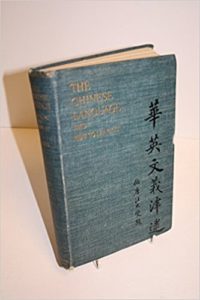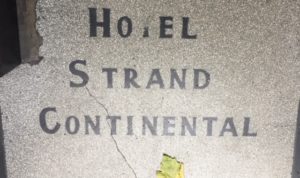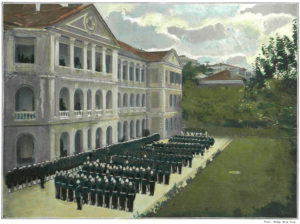Posted: December 8th, 2017 | No Comments »
The BBC’s new adaptation of Howards End was generally well received. For China Rhyming readers the last episode may elicit a slight raising of the eyebrow as Tibby Schlegel proudly displays his grasp of Chinese to his sister Margaret and displays well-thumbed, Chinese Grammar as he sits by the fire practicing his tones.
Tibby is in his final year at Oxford and “glancing” at his Chinese Grammar in case he should decide to try for a Student Interpreter post with the Foreign Office (as the lowest rung of the China Service was called – you moved from interpreter up the ranks). In the BBC version Tibby tries out a bit of Chinese on his sister – in Forster’s novel (1910) he merely studies it and keeps his tones to himself.
Tibby might have been immersed in the Reverend Donald MacGillivray’s A Mandarin-Romanized Dictionary of Chinese, probably the Chinese Grammar of choice for Edwardian scholars before the First World War. There are alternatives though and most likely for Tibby’s level of interest was Walter Craine Hillier’s The Chinese Language and How to Learn It (1907 – below). The book was very popular with language students and the generally interested early in the twentieth century.

Posted: December 7th, 2017 | No Comments »
A little deviation from China today, but an important one. The India Club on London’s Strand is an institution – not one for the super rich and wealthy, the particularly fashionable or the jet-set crowd. Rather it’s a place in the West End without pretensions that hasn’t changed much in nearly 70 years. To walk into the India Club (and anyone can) – the bar on the first floor and the restaurant on the second floor are a little whiff of the 1940s. It does quite good business despite being irredeemably old fashioned – barristers from the nearby chambers and law courts, academics and students from King’s, those who know their West End beyond the chains and the fly-by-night trendy eateries.
The Club has links to Krishna Menon (a former editor at Penguin Books and later India’s first High Commissioner to London) – Nehru and Lady Mountbatten were early members and patrons. The entire building was The Strand Continental Hotel at one point – and indeed part of the building is still a budget hotel. And so, of course, it’s under threat from developers and, of course, the developers want to rip it all out and create God only knows what horror. So there’s a campaign – see below….sign the petition, have a moan and then, if you haven’t, go and have some food and a beer and support them.






Posted: December 6th, 2017 | No Comments »
Not particularly China, but hopefully of interest to some…
I’ve probably read more crime this year than any other – writing the fortnightly Crime and the City column for The Literary Hub, the occasional article and review for the UK magazine Real Crime and various other bits and pieces of reviewing have all added up to a lot of reading. Much of it of course is not newly published but these are, to my mind, the best…
The Dry – Jane Harper’s debut novel was a master class in small-town tension in the Australian outback.
Police at the Station and they Don’t Look Friendly – Adrian McKinty is just firing on all cylinders with the Sean Duffy series and this, the sixth Duffy book, shows their plenty of mileage left.
The Long Drop – Denise Mina gave true crime literary non-fiction a go and triumphed in this tale of one long drunken Glasgow night with the serial killer Peter Manuel and his associates.
The Shadow District – Arnaldur Indridason’s first historic crime novel (I think) – Reykjavik in WW2 and a city full of American GIs with murder in the town’s darkest back alleys.
The Man Who Wanted to Know – D.A. Mishani’s latest Tel Aviv-set crime novel repeats his previous trick of making seemingly mundane lives in the blandewst of suburbs fascinating.
The Pictures – Guy Bolton’s period piece with an LAPD cop who’s covered up crimes for the Hollywood studios reaching his own personal breaking point.
A Necessary Evil – Abir Mukherjee’s second Sam Wyndham of the Calcutta Police in post-WW1 India tale hit the mark again with the second in what should be a great continuing series.
The King of Fools – Frederic Dard’s novella is not new, but it is new in English. Pushkin Press are translating a few new Dard books a year and, if you like your crime deep noir and consumable in one sitting, then Dard is the master.
The Force – Don Winslow did it again – ‘nough said really.
I would also note that espionage had a good year. John Le Carre’s A Legacy of Spies of course – Smiley returning was always going to be a big event; Adam Brookes’s Mangan trilogy completed with The Spy’s Daughter; and Joseph Kanon’s Defectors proved he is still top of the game.
On TV it was a sad farewell to Ripper Street matched only by an eager hello to The Deuce (episode 7 written by noir maestro Megan Abbott stood out as exceptional) while we kept right on with the Shelby clan and Peaky Blinders. I also enjoyed the Danish show Norskov, got pretty obsessed about the French show Mafiosa (set in Corsica), thought The Last Post (which had some criminal activity) from the BBC better than the critics did, and binge-watched the latest series of Bosch, the adaptation of Michael Connelly’s novels. I am, as we speak, right in the middle of the excellent Babylon Berlin and need to get back to it now. So that’s that for 2017.
Posted: December 5th, 2017 | No Comments »
The excellent London Fictions website has posted an article by Anne Witchard on MP Shiel’s 1898 The Yellow Danger…..(the entire article here)

China in the Western imagination has long been both the repository of fantasy and a mirror of our disquietudes. In the early twentieth century Sax Rohmer created the fiendish Dr Fu Manchu as the epitome of Chinese threat, ‘the yellow peril incarnate in one man’ intent on nothing less than the downfall of Western civilization.
​
Even beyond its cohort of unrepentant fans and equally vociferous detractors, Sax Rohmer’s Fu Manchu series (beginning in 1912) sustains a cultural longevity that merits our attention. That this dated generic phenomenon has now outspanned the century of its birth might be attributable to the fact that Rohmer’s super villain actually has his imaginative genesis in the 1890s. The closing decade of the Victorian era is redolent with metropolitan associations that remain iconic: Hansom cabs and Sherlock Holmes, mummy curses and murky gaslight, a visiting vampire count and Jack the Ripper.Â
We might date the start of an obsession with a Yellow Peril in British popular culture from 1898, its most notable marker being the publication that year of M. P. Shiel’s novel, The Yellow Danger.
Click here for the rest of the article
Posted: December 4th, 2017 | No Comments »
Renowned Hong Kong historian Tony Banham’s new book on the evacuation of allied women and children from Hong Kong in 1940…Reduced to a Symbolical Scale…

In July 1940, the wives and children of British families in Hong Kong, military and civilian, were compulsorily evacuated, following a plan created by the Hong Kong government in 1939. That plan focused exclusively on the process of evacuation, but issues concerning how the women and children should settle in the new country, communication with abandoned husbands, and reuniting families after the war were not considered. In practice, few would ever be addressed. When evacuation came, 3,500 people would simply be dumped in Australia.The experience of the evacuees can be seen as a three-act drama: delivery to Australia creates tension, five years of war and uncertainty intensify it, and resolution comes as war ends. However, that drama, unlike the evacuation plan, did not develop in a vacuum but was embedded in a complex historical, political, and social environment. Based on archival research of official documents, letters and memoirs, and interviews and discussions with more than one hundred evacuees and their families, this book studies the evacuation in its full context.
Posted: December 3rd, 2017 | No Comments »
The Wattis Gallery
Under Construction
A collection of fine paintings, prints and drawings

(Tai Kwun, Central Police Station, Hollywood Road, Hong Kong c.1885, Afung)
 The exhibition continues until Saturday 30th December 2017
Wattis Fine Art Gallery
Posted: December 2nd, 2017 | No Comments »
Penguin Specials have been around for 80 years this since the first in 1937 in the UK. Penguin have been publishing Specials since 2014 and I’ve enjoyed putting out three with them – Badlands: Decadent Playground of Old Peking (some follow up stories to my book Midnight in Peking); Betrayal in Paris: How the Treaty of Versailles Led to China’s Long Revolution (part of the Penguin Specials China in World War One series) and; Bloody Saturday: Shanghai’s Darkest Day (to commemorate the 80th anniversary of the Japanese attack on Shanghai).
This short video may give you some additional ideas from the Penguin China Specials range – available in paperback form in Asia and Australia and as e-books everywhere else…
Posted: December 1st, 2017 | No Comments »
I noticed that, with little mention i saw, Hou Bo died on the 26th November. She became known, with her husband Xi Xiaobing, as one of the closest photographers to Mao and had joined the Communist Party in 1938. After 1949 she and her husband lived close to Mao and had amazing access to him on a daily basis. “The Founding of the PRC” (1949), “Mao Zedong Swimming Across the Yangzi” (1955), “Chairman Mao at Work in an Airplane” (1959), “Mao Zedong with Students from Latin America” (1959) – all instantly recognizable and all Hou Bo.
 https://chinarhyming.com/wp-admin/post-new.php
https://chinarhyming.com/wp-admin/post-new.php
Xu Xiaobing, Hou Bo and Mao
Unsurprisingly Jiang Qing (herself an amateur photographer) went for Hou Bo during the Cultural Revolution but she survived and continued snapping away. She was an unrepentant Maoist and Communist Party member; she was happy to take and publish photographs during the Great Leap Forward that falsified the treu state of agricultural production on the country on the brink of starvation – her GLF era photograph of a straw hat wearing Mao among a field of giant corn remains a major piece of propaganda. So she was in many ways the Leni Riefenstahl of China – talented, capable of inconic work and a true believer.










 https://chinarhyming.com/wp-admin/post-new.php
https://chinarhyming.com/wp-admin/post-new.php